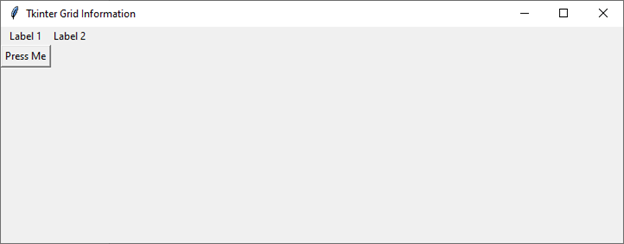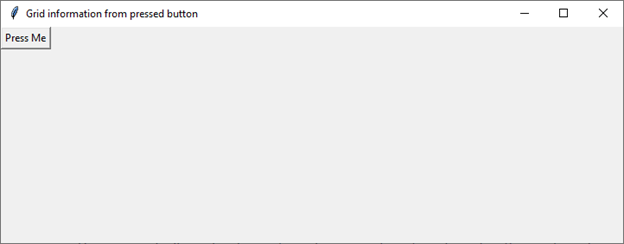
 Data Structure
Data Structure Networking
Networking RDBMS
RDBMS Operating System
Operating System Java
Java MS Excel
MS Excel iOS
iOS HTML
HTML CSS
CSS Android
Android Python
Python C Programming
C Programming C++
C++ C#
C# MongoDB
MongoDB MySQL
MySQL Javascript
Javascript PHP
PHP
- Selected Reading
- UPSC IAS Exams Notes
- Developer's Best Practices
- Questions and Answers
- Effective Resume Writing
- HR Interview Questions
- Computer Glossary
- Who is Who
How to get grid information from pressed Button in tkinter?
Organizing widgets in a grid layout is an important aspect of GUI design using Tkinter. In this tutorial, we will explain how you can obtain the row and column indices of widgets within a grid layout.
What is Tkinter Grid Layout?
Tkinter's grid geometry manager is widely used for arranging widgets in rows and columns. When widgets are placed using the grid method, they are assigned specific row and column indices. To understand how to retrieve this information dynamically, we'll first delve into the basics of grid layout in Tkinter.
Example
import tkinter as tk
# Create the main Tkinter window
root = tk.Tk()
root.title("Tkinter Grid Information")
root.geometry("720x250")
# Create widgets and position them using the grid method
label1 = tk.Label(root, text="Label 1")
label1.grid(row=0, column=0)
label2 = tk.Label(root, text="Label 2")
label2.grid(row=0, column=1)
button = tk.Button(root, text="Press Me")
button.grid(row=1, column=0)
# Run the Tkinter event loop
root.mainloop()
In the example above, we've created a simple Tkinter window with two labels and a button, positioned using the grid method. The labels are in the first row, and the button is in the second row. Now, let's explore how to retrieve the grid information of the pressed button.
Output
On running this code, you will get the following output window

Retrieving Grid Information from Pressed Buttons
To dynamically retrieve the grid information of a widget, such as a button, when it is pressed, we can use the bind method to associate a callback function with a specific event, such as a button click.
Let's modify our previous example to include a function that prints the grid information of the pressed button
Example
import tkinter as tk
def button_pressed(event):
# Get the widget that triggered the event
widget = event.widget
# Get the grid information of the widget
grid_info = widget.grid_info()
# Print the grid information
print("Row:", grid_info['row'])
print("Column:", grid_info['column'])
# Create the main Tkinter window
root = tk.Tk()
root.title("Grid information from pressed button")
root.geometry("720x250")
# Create a button and bind the button_pressed function to its command
button = tk.Button(root, text="Press Me")
button.grid(row=1, column=0)
# Bind the left mouse button click event
button.bind('<Button-1>', button_pressed)
# Run the Tkinter event loop
root.mainloop()
In this example, we've added the button_pressed function, which takes an event as an argument. Inside the function, we retrieve the widget that triggered the event using event.widget. We then use the grid_info() method to obtain the grid information of the widget, including the row and column indices. The retrieved information is printed to the console.
Output
On running this code, you will get the following output window

This approach allows developers to perform specific actions based on the position of a widget within the grid layout when it is interacted with.
Practical Use Cases
Understanding how to retrieve grid information from pressed buttons in Tkinter opens up various possibilities for enhancing the functionality and user experience of your GUI applications. Here are some practical use cases
Dynamic Layout Adjustments By knowing the grid position of a pressed button, developers can dynamically adjust the layout or appearance of other widgets based on user interactions. For example, changing the color or visibility of specific elements.
Data Retrieval and Processing In applications where data is displayed in a grid-like structure, clicking on a specific cell (represented by a button) can trigger the retrieval and processing of data associated with that position.
Game Development Grid layouts are common in game development, especially in board games. Retrieving grid information from pressed buttons allows developers to implement game logic based on user moves, such as making a move on a chessboard or revealing a cell in a minesweeper game.
Form Navigation In data entry forms, developers can use grid information to navigate between form fields or validate user inputs dynamically.
Conclusion
Retrieving grid information from pressed buttons in Tkinter provides developers with a powerful tool for creating dynamic and interactive GUI applications. Understanding the position of widgets within a grid layout opens the door to a wide range of possibilities, from adjusting layouts dynamically to implementing complex game logic.

